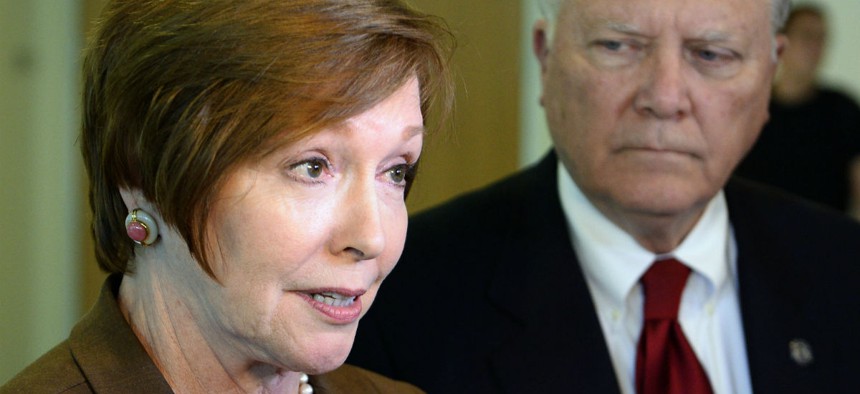Is the CDC Losing Control?
The country's flagship public-health agency is facing internal scandal and funding issues that will test its ability to respond to outbreaks on the horizon.
The Centers for Disease Control and Prevention was created, quite literally, to drain the swamp. In the not-so-far-off past, much of the southeastern United States was a malarial mess, with disease-carrying mosquitoes multiplying in the heat and moisture of the agricultural lowlands and wetlands that dominate the region. Before America became a superpower, the major threats to life and liberty weren’t terrorism or nuclear annihilation, but the annual scourge of fever diseases. When the CDC’s predecessor, the Office of Malaria Control in War Areas, was created in 1942, its mission was to knock down the remaining barriers to personal freedom these illnesses imposed. Or, to drain them.
Seventy-five years later, malaria and yellow fever have been all but eliminated in the continental United States. The morbidity and mortality burden for the worst infectious diseases has fallen tremendously over the last century, and average life expectancy has increased by over 10 years since 1942. At the center of it all is the CDC, now a major piece of both the public-health and national-security apparatuses, and a relative constant in times of great change. But as 2017 showed, few institutions are truly immune to the political upheaval the Trump administration brought to Washington—and now the stalwart CDC finds itself sinking into the swamp.
To say the agency has taken a step back in Trump’s first year would be an understatement. On Wednesday, the new secretary of Health and Human Services, Alex Azar, announced the resignation of CDC Director Brenda Fitzgerald, citing “complex financial interests that have imposed a broad recusal limiting her ability to complete all her duties.” According to a recent report from Politico, some of those holdings included eyebrow-raising investments in companies directly related to Fitzgerald’s work, including thousands of dollars in drug and insurance companies.
Close ties with these industries aren’t unusual among Trump administration officials: Former Health Secretary Tom Price had stock in biotech and pharmaceuticals companies, and Azar is a former executive with pharmaceutical giant Eli Lilly. But Fitzgerald’s financial activity went even beyond this new norm. Politico reported that she’d held stock in tobacco companies Reynolds American, British American Tobacco, Imperial Brands, Philip Morris International, and Altria Group before she took office in July. As director, she purchased over $1,000 worth of stock in Japan Tobacco. That means that before she dumped the stocks in October, Fitzgerald held ownership in four of the “Big Five” tobacco companies in the world.
Now, there are no accusations of wrongdoing against Fitzgerald—no indication her stake made a difference in her leadership—and it’s unclear if she was aware of the stock purchases made in her name. But even the most generous interpretation for Fitzgerald is a scandal for the CDC. One of the centers’ chief public-health objectives is to end smoking. In fact, the only real public-health position on tobacco usage is that it should be eliminated entirely, a line that the CDC has held for years now. The CDC’s chief holding even a penny of tobacco stock, let alone a portfolio that includes almost all the major companies, runs counter to that goal.
This particular fiasco comes during a time when the agency is facing a growing number of public-health threats. Smoking rates have dipped significantly in the past year, but the disparities in smoking rates between rich and poor have actually increased—differences that threaten to further entrench income inequality. Antibiotic resistance is on the rise, and more than likely portends a new wave of infectious threats that will test the American public-health system, including the imminent threat of a resurgence of sexually-transmitted diseases. The country is in the grip of one of the worst flu seasons in years, and the unprecedented opioid crisis decreasing the lifespans of millions of Americans shows no signs of relenting.
Facing that rising tide, the mothership of the country’s public-health system is floundering, in no small part because of a Republican effort to reduce its funding. In 2017, the GOP’s attempts to repeal Obamacare often proposed raiding or eliminating the Prevention and Public Health Fund, which constitutes a major piece of the CDC’s budget. While repeal never passed, it put CDC on the defensive, where it’s likely to remain: Trump has also targeted the fund for cuts.
What’s more, facing a loss of funding for its international infectious-disease efforts—there appear to be “no new resources” on the horizon—the agency is set to cut back its global health-security program by as much as 80 percent. In a hotter, more connected world, when global pandemic seems all the more likely, the CDC is shrinking from the world.
Paradoxically, the failure of global diseases like Ebola and Zika to establish beachheads in the United States after sustained panics has often been used as rationale for pulling the agency back and slashing its proactive public-health funds. But renewed austerity, along with controversy in leadership, could set the CDC up for failure precisely at the moment when it is needed most.



